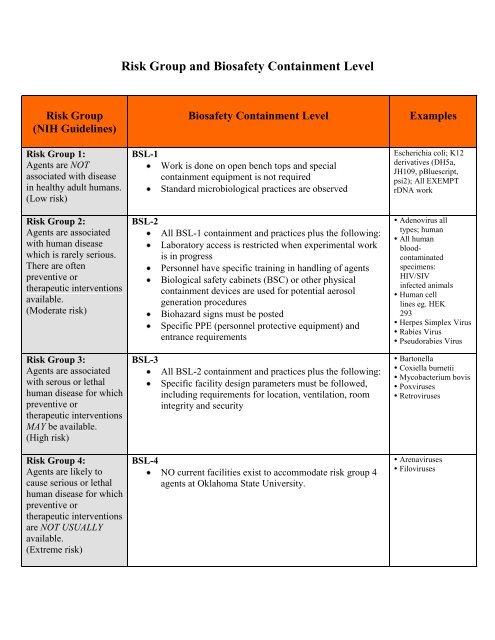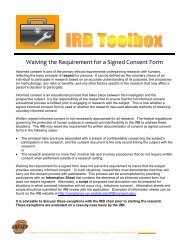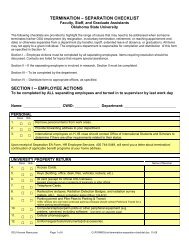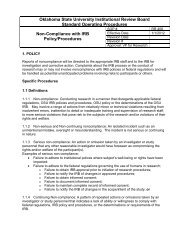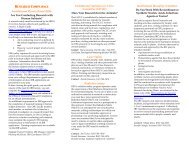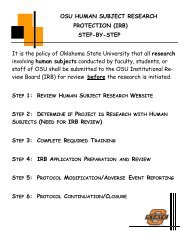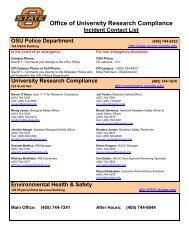Risk Group and Biosafety Level Containment - University Research ...
Risk Group and Biosafety Level Containment - University Research ...
Risk Group and Biosafety Level Containment - University Research ...
You also want an ePaper? Increase the reach of your titles
YUMPU automatically turns print PDFs into web optimized ePapers that Google loves.
<strong>Risk</strong> <strong>Group</strong> <strong>and</strong> <strong>Biosafety</strong> <strong>Containment</strong> <strong>Level</strong><strong>Risk</strong> <strong>Group</strong>(NIH Guidelines)<strong>Biosafety</strong> <strong>Containment</strong> <strong>Level</strong>Examples<strong>Risk</strong> <strong>Group</strong> 1:Agents are NOTassociated with diseasein healthy adult humans.(Low risk)<strong>Risk</strong> <strong>Group</strong> 2:Agents are associatedwith human diseasewhich is rarely serious.There are oftenpreventive ortherapeutic interventionsavailable.(Moderate risk)<strong>Risk</strong> <strong>Group</strong> 3:Agents are associatedwith serous or lethalhuman disease for whichpreventive ortherapeutic interventionsMAY be available.(High risk)<strong>Risk</strong> <strong>Group</strong> 4:Agents are likely tocause serious or lethalhuman disease for whichpreventive ortherapeutic interventionsare NOT USUALLYavailable.(Extreme risk)BSL-1BSL-2BSL-3BSL-4Work is done on open bench tops <strong>and</strong> specialcontainment equipment is not requiredSt<strong>and</strong>ard microbiological practices are observedAll BSL-1 containment <strong>and</strong> practices plus the following:Laboratory access is restricted when experimental workis in progressPersonnel have specific training in h<strong>and</strong>ling of agentsBiological safety cabinets (BSC) or other physicalcontainment devices are used for potential aerosolgeneration proceduresBiohazard signs must be postedSpecific PPE (personnel protective equipment) <strong>and</strong>entrance requirementsAll BSL-2 containment <strong>and</strong> practices plus the following:Specific facility design parameters must be followed,including requirements for location, ventilation, roomintegrity <strong>and</strong> securityNO current facilities exist to accommodate risk group 4agents at Oklahoma State <strong>University</strong>.Escherichia coli; K12derivatives (DH5a,JH109, pBluescript,psi2); All EXEMPTrDNA work• Adenovirus alltypes; human• All humanbloodcontaminatedspecimens:HIV/SIVinfected animals• Human celllines eg. HEK293• Herpes Simplex Virus• Rabies Virus• Pseudorabies Virus• Bartonella• Coxiella burnetii• Mycobacterium bovis• Poxviruses• Retroviruses• Arenaviruses• Filoviruses
<strong>Risk</strong> <strong>Group</strong> <strong>and</strong> <strong>Biosafety</strong> <strong>Containment</strong> <strong>Level</strong> for Animal,Plant, or rDNA not related to risk in Humans<strong>Risk</strong> <strong>Group</strong>(NIH Guidelines)<strong>Risk</strong> <strong>Group</strong> 1:Experiments that do notpose a risk to theenvironment – releasewould not result insurviving in theenvironment. (Low risk)<strong>Risk</strong> <strong>Group</strong> 2:Experiments that involvework agents or transgenicsthat if released would beviable in the environmentbut would have anegligible impact or couldbe readily managed.(Moderate risk)<strong>Risk</strong> <strong>Group</strong> 3:Experiments that a releaseoutside the lab would havesignificant detrimentalimpact on the environment.(High risk)<strong>Risk</strong> <strong>Group</strong> 4:Experiments with exoticsthat are serious pathogensof major US crops <strong>and</strong>agriculture, <strong>and</strong> wouldhave a devastating impacton the environment.(Extreme risk)BSL-1BSL-2BSL-3BSL-4<strong>Biosafety</strong> <strong>Containment</strong> <strong>Level</strong>Work is done on open bench tops <strong>and</strong> specialcontainment equipment is not requiredSt<strong>and</strong>ard microbiological practices are observedAll BSL-1 containment <strong>and</strong> practices plus thefollowing:Laboratory/Facility/Greenhouse access is restrictedwhen experimental work is in progressPersonnel have specific training in h<strong>and</strong>ling of agentsBiological safety cabinets (BSC) or other physicalcontainment devices are used for potential aerosolgeneration proceduresBiohazard signs must be postedSpecific PPE (personnel protective equipment) <strong>and</strong>entrance requirementsAll BSL-2 containment <strong>and</strong> practices plus thefollowing:Specific facility design parameters must be followed,including requirements for location, ventilation, roomintegrity <strong>and</strong> securityNO current facilities exist to accommodate risk group4 agents at Oklahoma State <strong>University</strong>.ExamplesEscherichia coli; K12derivatives (DH5a,JH109, pBluescript,psi2); All EXEMPTrDNA work;Rhizobium,Agrobacterium• rDNA work on plantsthat could becomeestablished if released• Potentially harmfulmicroorganisms toother animals or plantsbut that are manageable•Exotics that pose nopotential harm tomanaged or naturalecosystems• Herpes Simplex Virus• Rabies Virus• Pseudorabies Virus• Exotic infectiousagents capable ofcausing seriousenvironmental harm• Plants containinggenes from exoticinfectious agents• Mycobacterium bovis


